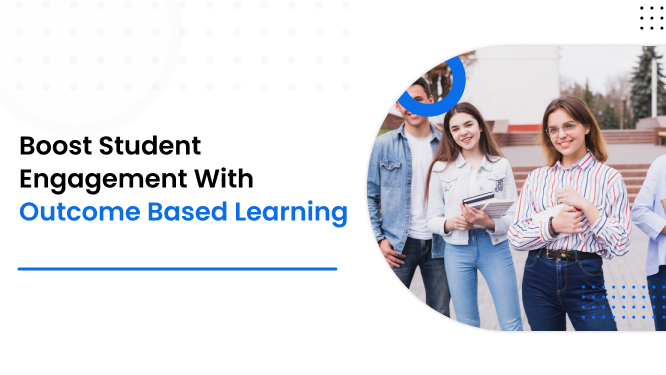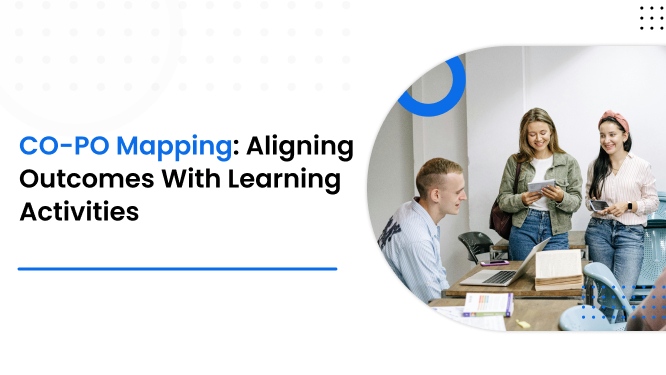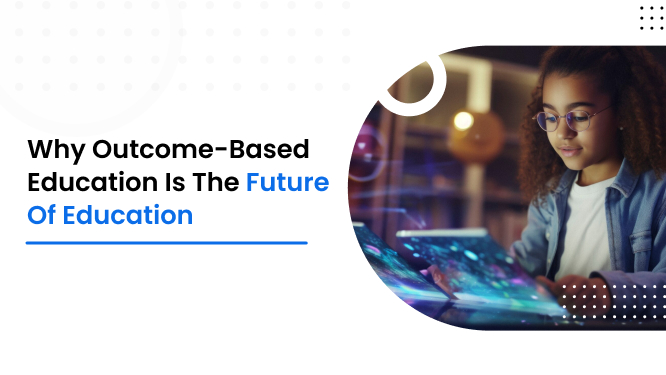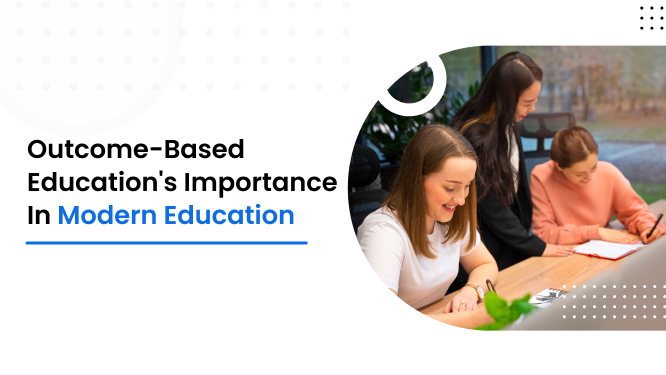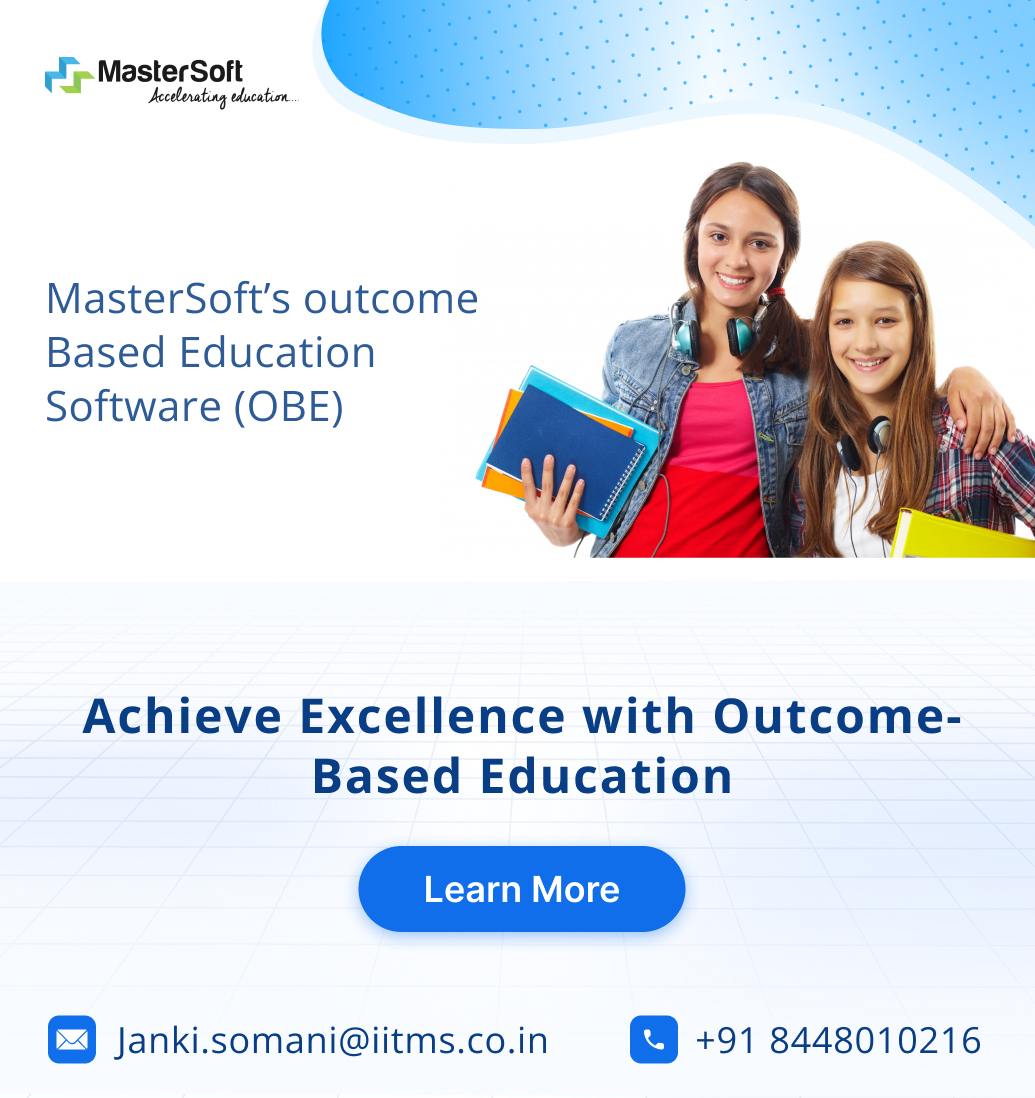Boost Student Engagement with Outcome Based Learning
Outcome Based Learning, also commonly known as Outcome-Based Education (OBE) is changing the way we think about education.
Instead of focusing on how teaching is done, OBE emphasizes what students actually learn and achieve. This means that all educational activities are designed to help students gain specific, measurable skills and knowledge that are crucial for their success.
OBE isn't just a teaching method; it's a complete system that includes curriculum design, teaching strategies, and assessment methods, all aimed at helping students reach their goals.
Outcome Based Learning has been adopted in response to the evolving needs of the workforce and society. It highlights the importance of applying knowledge, thinking critically, and solving problems, which are key skills for tackling real-world challenges. In this blog, we will understand how Outcome Based Learning boosts student engagement.
Understanding Outcome Based Learning
Outcome Based Learning puts students at the center of learning by focusing on measurable outcomes rather than traditional teaching methods. It's designed to help all students develop the skills they need to thrive in today's fast-paced world. Let's take a closer look at Outcome Based Learning with the latest information and data:
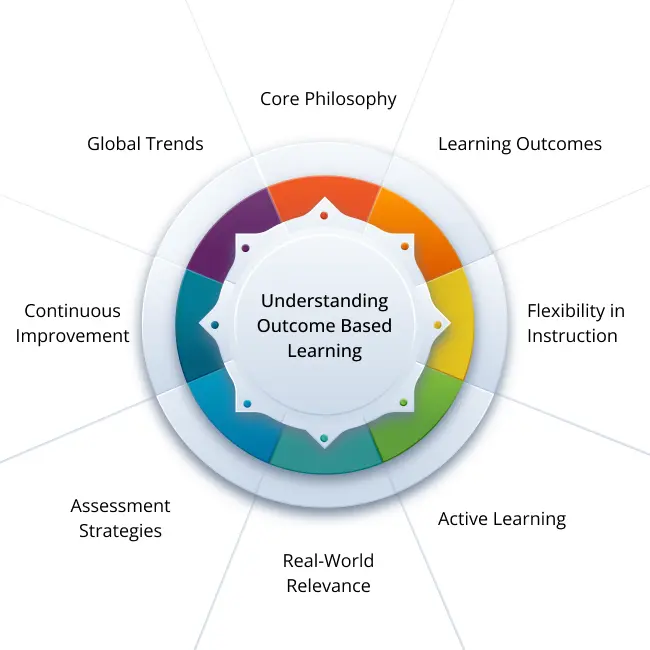
- Core Philosophy: Outcome Based Learning is based on the idea that every student can succeed. Success is measured by their ability to demonstrate specific outcomes, not just by the time they spend in school.
-
Learning Outcomes: These are clear statements that describe what students should know and be able to do by the end of a course or program. They are:
- Specific: Clearly defined to avoid any confusion.
- Measurable: Quantifiable so progress can be tracked.
- Achievable: Realistic within the available resources and time.
- Relevant: Aligned with industry needs and personal growth.
- Time-bound: Set to be completed within a specific timeframe.
- Flexibility in Instruction: Outcome Based Learning allows for various teaching methods, encouraging diverse approaches to achieve the desired outcomes.
- Active Learning: By focusing on outcomes, students engage more deeply with the material, understanding not just what they are learning but why it matters.
- Real-World Relevance: OBE ensures that the skills and knowledge students gain are directly applicable to real-life situations, enhancing their employability and problem-solving abilities.
-
Assessment Strategies: In OBE, assessments are designed to see if students have achieved the specified outcomes. These can include:
- Formative Assessments: Regular feedback during the learning process.
- Summative Assessments: Evaluations at the end of a learning period.
- Performance Tasks: Real-world challenges that test applied knowledge.
- Continuous Improvement: Assessment data is used to improve teaching methods and curriculum design, ensuring education remains relevant and effective.
- Global Trends: Recent studies show that OBE is evolving into three types: Traditional, Transitional, and Transformational, reflecting a more comprehensive and skill-centered approach in modern education.
The shift towards Outcome Based Learning is driven by the need for education systems to meet the demands of the 21st century. By focusing on outcomes, educators ensure that students aren't just learning but learning with a purpose.
The Shift to Outcome Based Learning in the Education Sector
The transition to Outcome Based Learning is a major global trend, with many countries adopting this approach to meet the changing needs of the 21st century. Let's explore this shift to OBE with some of the latest information and data:
- Global Adoption: Outcome Based Learning is being embraced worldwide, from Australia to Malaysia, South Africa, and the European Union. Each region adapts OBE to match its unique educational goals and societal needs.
- Industry Alignment: By focusing on outcomes, OBE ensures that students learn skills that are directly relevant to the workforce. This is crucial in a world where technology rapidly changes job requirements.
- Accountability: Schools and universities are increasingly accountable for their graduates' success. OBE's focus on measurable outcomes provides a clear framework for showing how effective their programs are.
- Continuous Improvement: Outcome Based Learning encourages ongoing feedback and refinement, making sure that educational programs stay responsive to student needs and industry trends.
- Flexibility in Teaching: OBE supports various teaching methods, as long as they help achieve the desired outcomes. This flexibility caters to different learning styles and fosters innovation in teaching.
- Assessment Reforms: Traditional exams are being supplemented or replaced by performance-based assessments that better reflect students' ability to apply their knowledge in real-world situations.
- Lifelong Learning: OBE promotes skills like critical thinking and adaptability, which are essential for lifelong learning in our ever-changing world.
- Challenges and Criticisms: Despite its benefits, OBE faces challenges, such as the complexity of implementing systemic changes and ensuring all students have access to quality education.
The move to Outcome Based Learning represents a significant shift in educational philosophy. It moves away from a one-size-fits-all approach to a more personalized and results-focused system. This change recognizes that traditional education models aren't enough to prepare students for modern life's complexities. Outcome Based Learning is shaping the future of learning, with more educational institutions worldwide rethinking their curricula, teaching methods, and assessment practices to better serve students and society.
Engaging Students Through Outcome Based Learning
Engagement is at the heart of Outcome Based Learning, with the goal of creating a deep and meaningful connection between students and their learning. Here’s how OBE engages students, using the latest information and data:

- Purpose-Driven Learning: In OBE, students are more engaged when they see how their learning activities connect to their personal and professional goals. This understanding boosts their motivation and involvement.
-
Diverse Instructional Strategies: OBE's flexibility supports various teaching methods, such as:
- Collaborative Projects: Promoting teamwork and communication.
- Technology-Enhanced Simulations: Providing interactive and immersive learning experiences.
- Game-Based Learning: Using educational games to make learning fun and engaging.
- Active Learning: OBE encourages active learning, where students participate actively rather than just receiving information.
- Real-World Application: Assignments and projects in OBE often reflect real-world challenges, making learning more relevant and engaging for students.
- Customized Feedback: OBE offers personalized feedback, helping students understand their progress and identify areas for improvement.
- Continuous Engagement: Research shows that continuous engagement in Outcome Based Learning leads to higher retention rates and better academic performance.
- Emotional and Social Engagement: Creating a supportive environment is key to encouraging students to participate and take intellectual risks.
- Cognitive Engagement: Outcome Based Learning promotes critical thinking and problem-solving, engaging students at a deeper intellectual level.
By integrating these strategies, OBE does more than just capture students' attention. It also creates an environment where they are actively involved in shaping their learning journey. This involvement is crucial for deepening their understanding and equipping them with skills to apply their knowledge in various contexts. The latest trends in Outcome Based Learning highlight the importance of engagement in creating a dynamic and effective learning experience that prepares students for success both in and out of the classroom.
Strategies for Implementing Outcome Based Learning
Implementing Outcome Based Learning is a strategic process that transforms the educational experience to prioritize achieving specific learning outcomes. Let's dive into the strategies for implementing OBE, enriched with the latest information and data:
Curriculum Development:
The curriculum is built around the end goals, making sure every part of the learning experience helps achieve the desired outcomes. This includes identifying essential skills and knowledge, integrating themes that cut across different subjects, and focusing on skills rather than just content.
Teaching Methods:
Educators choose various teaching methods that best help students achieve outcomes, such as:
- Project-Based Learning: Engage students in solving real-world problems.
- Experiential Activities: for students to gain hands-on experiences.
- Technology-Integrated Instruction: Using digital tools to enhance learning.
Assessment Practices:
Assessments provide ongoing feedback instead of just final grades. They include:
- Formative Assessments: Regular feedback for improvement.
- Summative Assessments: Evaluating outcomes at the end of a learning period.
- Authentic Assessments: Measuring skills in real-world situations.
Alignment of Components:
Everything—from the curriculum to teaching and assessment—is aligned with the defined outcomes to ensure a smooth learning experience.
Data-Driven Decision Making:
Institutions use data to improve their Outcome Based Learning strategies, ensuring they meet student needs.
Professional Development:
Educators receive training to implement OBE effectively and adapt to new teaching roles.
Stakeholder Involvement:
Success with Outcome Based Learning requires collaboration among everyone involved, including students, educators, and industry partners.
Continuous Improvement:
OBE is a continuous process with regular reviews and updates to the curriculum and teaching methods based on feedback and outcomes.
These strategies highlight the importance of a well-planned approach to OBE, which has been shown to increase student engagement by 25% and graduation rates by 15%, while also enhancing institutional effectiveness by 20%. By focusing on outcomes, educators can create a more dynamic, relevant, and effective educational experience that prepares students for the challenges of the future.
The Role of Technology in Outcome Based Learning
Technology is more than just an enabler, it is a catalyst in implementing Outcome Based Learning. It revolutionizes how educational content is delivered, experienced, and assessed. Here's an expanded view of the role of technology in OBE, with the latest information and data:
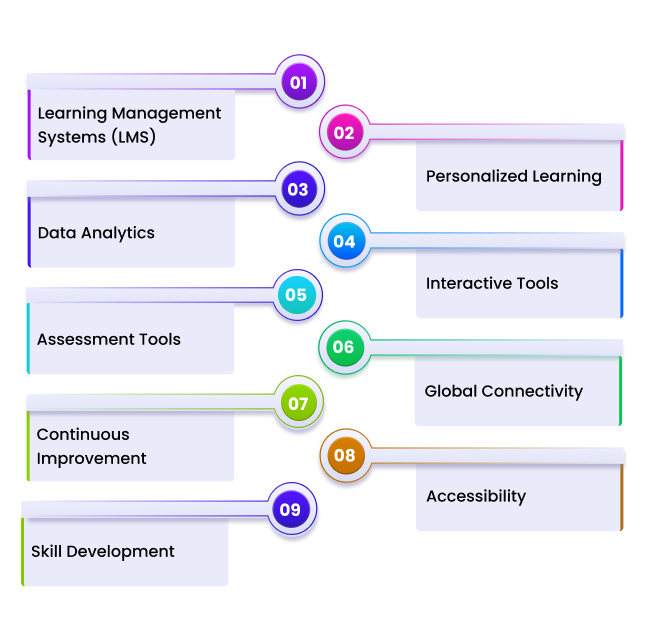
Learning Management Systems (LMS):
These platforms are essential for technology-driven OBE. They help manage learning content, track student progress, and facilitate communication between students and educators.
Personalized Learning:
Technology allows for personalized learning paths that adapt to each student's pace and style, ensuring that all learners can achieve their goals.
Data Analytics:
Using big data and analytics in education provides insights into student performance, helping educators make informed decisions to improve teaching strategies.
Interactive Tools:
Technology offers interactive tools like simulations and virtual labs that engage students in active learning, making complex concepts easier to understand.
Assessment Tools:
Advanced technology provides various assessment tools, from online quizzes to e-portfolios, aligning with OBE's focus on demonstrating competencies.
Global Connectivity:
Technology bridges geographical gaps, enabling global collaboration and exposure to diverse perspectives, which is essential in today's interconnected world.
Continuous Improvement:
The iterative nature of technology aligns with OBE's philosophy of continuous improvement, allowing regular updates to curriculum and teaching methods based on feedback.
Accessibility:
Assistive technologies ensure that Outcome Based Learning is inclusive, providing equal opportunities for all students, regardless of physical or learning disabilities.
Skill Development:
With technology advancing rapidly, there is a growing need for graduates proficient in digital skills. Technology in OBE helps equip students with these essential skills.
Integrating technology in Outcome Based Learning significantly boosts learning levels, increases engagement and motivation, and improves performance on assessments across educational settings.
Challenges and Best Practices in Outcome Based Learning
Outcome Based Learning is widely recognized for its potential to transform educational systems. However, implementing OBE comes with a set of challenges that educators and institutions must navigate. Let’s take a detailed look at the challenges and best practices in OBE, incorporating up-to-date information and data:
Challenges
- Assessment Design: Creating assessments that accurately measure outcomes is complex. They need to be valid, reliable, and aligned with the intended outcomes.
- Faculty Training: Educators need proper training to shift from traditional teaching methods to outcome-based approaches.
- Curriculum Alignment: Ensuring the curriculum matches the desired outcomes requires constant review and adaptation.
- Resource Allocation: Implementing Outcome Based Learning can demand significant resources, both in technology and personnel.
- Stakeholder Buy-In: Getting support from all stakeholders, including students, parents, and industry partners, is crucial for successful implementation.
- Equity and Access: Providing equal access to quality education for all students remains a persistent challenge.
Best Practices
- Collaborative Development: Involving stakeholders in developing outcomes and assessments ensures relevance and buy-in.
- Professional Development: Continuous training for educators is essential to equip them with the skills needed for Outcome Based Learning.
- Data-Driven Decisions: Using data to guide decisions can help refine OBE strategies and improve student outcomes.
- Technology Integration: Leveraging technology aids in efficiently delivering content and tracking student progress.
- Continuous Review: Regularly reviewing and updating OBE strategies ensures they remain effective and relevant.
- Inclusive Practices: Implementing strategies that promote equity and access for all students is vital for OBE’s success.
The challenges of Outcome Based Learning are significant, but with careful planning and adherence to best practices, they can be overcome. Recent studies show that when these best practices are implemented, there is a marked improvement in both teaching quality and student learning outcomes. Institutions that have successfully navigated these challenges report increased student engagement, higher retention rates, and better alignment with industry needs.
Recent studies show that when these best practices are implemented, there is a marked improvement in both teaching quality and student learning outcomes.
Institutions that have successfully navigated these challenges report increased student engagement, higher retention rates, and better alignment with industry needs.
End Note
Outcome Based Learning is more than just an educational buzzword; it's a powerful approach that can transform the way we teach and learn. By focusing on outcomes, educators can create a learning environment that is engaging, relevant, and effective.
